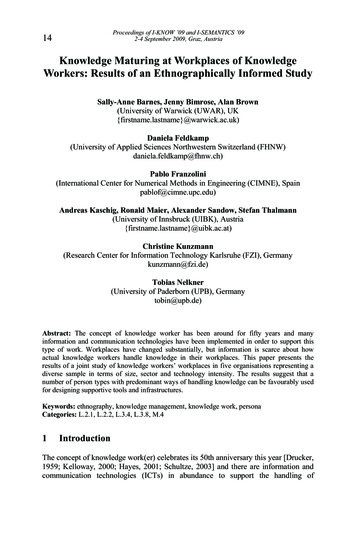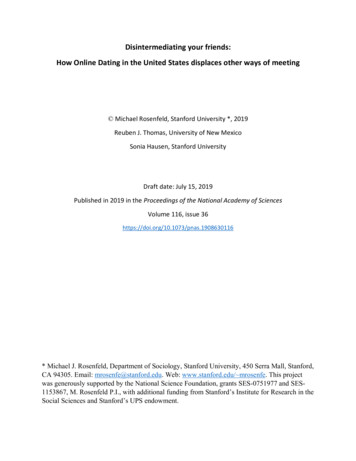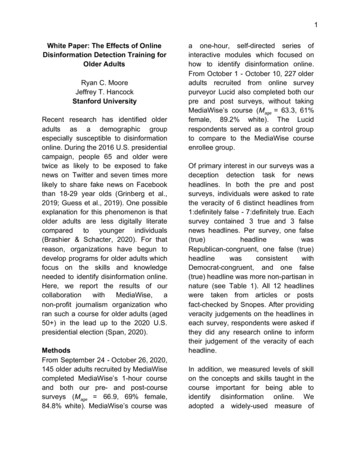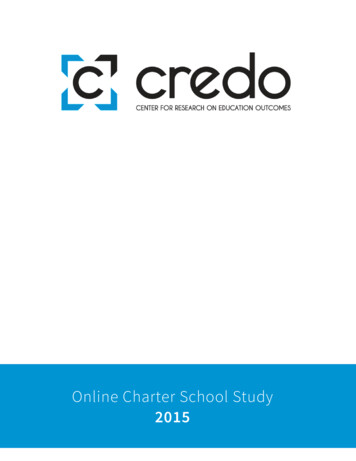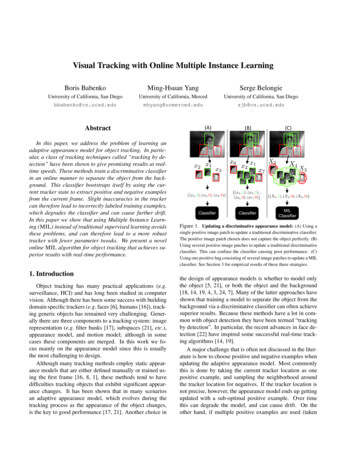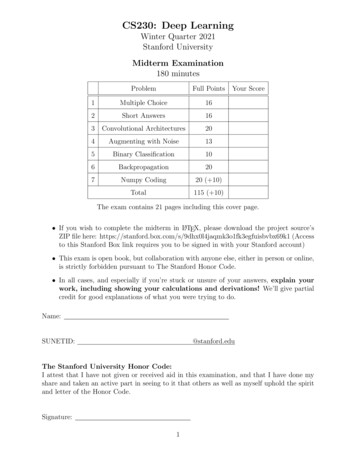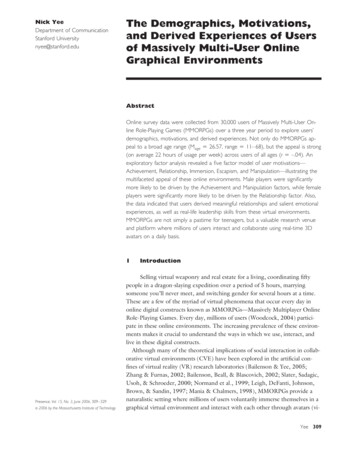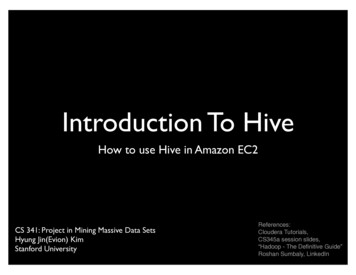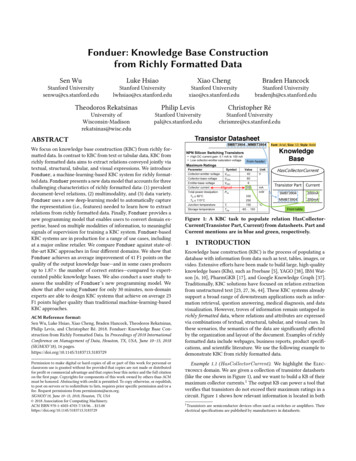
Transcription
Fonduer: Knowledge Base Constructionfrom Richly Formatted DataSen WuLuke HsiaoXiao ChengBraden HancockStanford Universitysenwu@cs.stanford.eduStanford Universitylwhsiao@cs.stanford.eduStanford Universityxiao@cs.stanford.eduStanford Universitybradenjh@cs.stanford.eduTheodoros RekatsinasPhilip LevisChristopher RéUniversity ofWisconsin-Madisonrekatsinas@wisc.eduStanford Universitypal@cs.stanford.eduStanford Universitychrismre@cs.stanford.eduTransistor DatasheetABSTRACTSMBT3904.MMBT3904We focus on knowledge base construction (KBC) from richly formatted data. In contrast to KBC from text or tabular data, KBC fromrichly formatted data aims to extract relations conveyed jointly viatextual, structural, tabular, and visual expressions. We introduceFonduer, a machine-learning-based KBC system for richly formatted data. Fonduer presents a new data model that accounts for threechallenging characteristics of richly formatted data: (1) prevalentdocument-level relations, (2) multimodality, and (3) data variety.Fonduer uses a new deep-learning model to automatically capturethe representation (i.e., features) needed to learn how to extractrelations from richly formatted data. Finally, Fonduer provides anew programming model that enables users to convert domain expertise, based on multiple modalities of information, to meaningfulsignals of supervision for training a KBC system. Fonduer-basedKBC systems are in production for a range of use cases, includingat a major online retailer. We compare Fonduer against state-ofthe-art KBC approaches in four different domains. We show thatFonduer achieves an average improvement of 41 F1 points on thequality of the output knowledge base—and in some cases producesup to 1.87 the number of correct entries—compared to expertcurated public knowledge bases. We also conduct a user study toassess the usability of Fonduer’s new programming model. Weshow that after using Fonduer for only 30 minutes, non-domainexperts are able to design KBC systems that achieve on average 23F1 points higher quality than traditional machine-learning-basedKBC approaches.ACM Reference format:Sen Wu, Luke Hsiao, Xiao Cheng, Braden Hancock, Theodoros Rekatsinas,Philip Levis, and Christopher Ré. 2018. Fonduer: Knowledge Base Construction from Richly Formatted Data. In Proceedings of 2018 InternationalConference on Management of Data, Houston, TX, USA, June 10–15, 2018(SIGMOD’18), 16 ssion to make digital or hard copies of all or part of this work for personal orclassroom use is granted without fee provided that copies are not made or distributedfor profit or commercial advantage and that copies bear this notice and the full citationon the first page. Copyrights for components of this work owned by others than ACMmust be honored. Abstracting with credit is permitted. To copy otherwise, or republish,to post on servers or to redistribute to lists, requires prior specific permission and/or afee. Request permissions from permissions@acm.org.SIGMOD’18, June 10–15, 2018, Houston, TX, USA 2018 Association for Computing Machinery.ACM ISBN 978-1-4503-4703-7/18/06. . . 15.00https://doi.org/10.1145/3183713.3183729NPN Silicon Switching Transistors High DC current gain: 0.1 mA to 100 mA Low collector-emitter saturation voltageMaximum RatingsParameterSymbolCollector-emitter voltageVCEOCollector-base voltageVCBOEmitter-base voltageVEBOCollector currentICAlignedTotal power dissipationTS 60 CTS 115 CPtotJunction temperatureTjStorage temperatureTstgFrom headerValue40UnitVFont: Arial; Size: 12; Style: SS250S150-65 . 150Transistor Part CurrentSMBT3904200mAMMBT3904200mA CFrom tableFigure 1: A KBC task to populate relation HasCollectorCurrent(Transistor Part, Current) from datasheets. Part andCurrent mentions are in blue and green, respectively.1INTRODUCTIONKnowledge base construction (KBC) is the process of populating adatabase with information from data such as text, tables, images, orvideo. Extensive efforts have been made to build large, high-qualityknowledge bases (KBs), such as Freebase [5], YAGO [38], IBM Watson [6, 10], PharmGKB [17], and Google Knowledge Graph [37].Traditionally, KBC solutions have focused on relation extractionfrom unstructured text [23, 27, 36, 44]. These KBC systems alreadysupport a broad range of downstream applications such as information retrieval, question answering, medical diagnosis, and datavisualization. However, troves of information remain untapped inrichly formatted data, where relations and attributes are expressedvia combinations of textual, structural, tabular, and visual cues. Inthese scenarios, the semantics of the data are significantly affectedby the organization and layout of the document. Examples of richlyformatted data include webpages, business reports, product specifications, and scientific literature. We use the following example todemonstrate KBC from richly formatted data.Example 1.1 (HasCollectorCurrent). We highlight the Electronics domain. We are given a collection of transistor datasheets(like the one shown in Figure 1), and we want to build a KB of theirmaximum collector currents.1 The output KB can power a tool thatverifies that transistors do not exceed their maximum ratings in acircuit. Figure 1 shows how relevant information is located in both1 Transistorsare semiconductor devices often used as switches or amplifiers. Theirelectrical specifications are published by manufacturers in datasheets.
the document header and table cells and how their relationship isexpressed using semantics from multiple modalities.The heterogeneity of signals in richly formatted data poses a major challenge for existing KBC systems. The above example showshow KBC systems that focus on text data—and adjacent textualcontexts such as sentences or paragraphs—can miss important information due to this breadth of signals in richly formatted data.We review the major challenges of KBC from richly formatted data.Challenges. KBC on richly formatted data poses a number ofchallenges beyond those present with unstructured data: (1) accommodating prevalent document-level relations, (2) capturing themultimodality of information in the input data, and (3) addressingthe tremendous data variety.Prevalent Document-Level Relations We define the context ofa relation as the scope information that needs to be considered whenextracting the relation. Context can range from a single sentenceto a whole document. KBC systems typically limit the contextto a few sentences or a single table, assuming that relations areexpressed relatively locally. However, for richly formatted data,many relations rely on the context of a whole document.Example 1.2 (Document-Level Relations). In Figure 1, transistorparts are located in the document header (boxed in blue), and thecollector current value is in a table cell (boxed in green). Moreover,the interpretation of some numerical values depends on their unitsreported in another table column (e.g., 200 mA).Limiting the context scope to a single sentence or table misses manypotential relations—up to 97% in the Electronics application. Onthe other hand, considering all possible entity pairs in a documentas candidates renders the extraction problem computationally intractable due to the combinatorial explosion of candidates.Multimodality Classical KBC systems model input data as unstructured text [23, 26, 36]. In richly formatted data, semantics arepart of multiple modalities—textual, structural, tabular, and visual.Example 1.3 (Multimodality). In Figure 1, important information(e.g., the transistor names in the header) is expressed in larger, boldfonts (displayed in yellow). Furthermore, the meaning of a tableentry depends on other entries with which it is visually or tabularlyaligned (shown by the red arrow). For instance, the semantics of anumeric value is specified by an aligned unit.Semantics from different modalities can vary significantly but canconvey complementary information.Data Variety With richly formatted data, there are two primarysources of data variety: (1) format variety (e.g., file or table formatting) and (2) stylistic variety (e.g., linguistic variation).Example 1.4 (Data Variety). In Figure 1, numeric intervals are expressed as “-65 . . . 150,” but other datasheets show intervals as “-65 150,” or “-65 to 150.” Similarly, tables can be formatted with a varietyof spanning cells, header hierarchies, and layout orientations.Data variety requires KBC systems to adopt data models that aregeneralizable and robust against heterogeneous input data.Our Approach. We introduce Fonduer, a machine-learningbased system for KBC from richly formatted data. Fonduer takes asinput richly formatted documents, which may be of diverse formats,including PDF, HTML, and XML. Fonduer parses the documentsand analyzes the corresponding multimodal, document-level contexts to extract relations. The final output is a knowledge base withthe relations classified to be correct. Fonduer’s machine-learningbased approach must tackle a series of technical challenges.Technical Challenges The challenges in designing Fonduer are:(1) Reasoning about relation candidates that are manifested in heterogeneous formats (e.g., text and tables) and span an entire document requires Fonduer’s machine-learning model to analyze heterogeneous, document-level context. While deep-learning modelssuch as recurrent neural networks [2] are effective with sentenceor paragraph-level context [22], they fall short with document-levelcontext, such as context that span both textual and visual features(e.g., information conveyed via fonts or alignment) [21]. Developingsuch models is an open challenge and active area of research [21].(2) The heterogeneity of contexts in richly formatted data magnifiesthe need for large amounts of training data. Manual annotation isprohibitively expensive, especially when domain expertise is required. At the same time, human-curated KBs, which can be usedto generate training data, may exhibit low coverage or not existaltogether. Alternatively, weak supervision sources can be used toprogrammatically create large training sets, but it is often unclearhow to consistently apply these sources to richly formatted data.Whereas patterns in unstructured data can be identified based ontext alone, expressing patterns consistently across different modalities in richly formatted data is challenging.(3) Considering candidates across an entire document leads to acombinatorial explosion of possible candidates, and thus randomvariables, which need to be considered during learning and inference. This leads to a fundamental tension between building apractical KBC system and learning accurate models that exhibithigh recall. In addition, the combinatorial explosion of possiblecandidates results in a large class imbalance, where the numberof “True” candidates is much smaller than the number of “False”candidates. Therefore, techniques that prune candidates to balancerunning time and end-to-end quality are required.Technical Contributions Our main contributions are as follows:(1) To account for the breadth of signals in richly formatted data,we design a new data model that preserves structural and semanticinformation across different data modalities. The role of Fonduer’sdata model is twofold: (a) to allow users to specify multimodaldomain knowledge that Fonduer leverages to automate the KBCprocess over richly formatted data, and (b) to provide Fonduer’smachine-learning model with the necessary representation to reason about document-wide context (see Section 3).(2) We empirically show that existing deep-learning models [46] tailored for text information extraction (such as long short-term memory (LSTM) networks [18]) struggle to capture the multimodality ofrichly formatted data. We introduce a multimodal LSTM networkthat combines textual context with universal features that correspond to structural and visual properties of the input documents.
These features are captured by Fonduer’s data model and are generated automatically (see Section 4.2). We also introduce a series ofdata layout optimizations to ensure the scalability of Fonduer tomillions of document-wide candidates (see Appendix C).(3) Fonduer introduces a programming model in which no development cycles are spent on feature engineering. Users only needto specify candidates, the potential entries in the target KB, andprovide lightweight supervision rules which capture a user’s domain knowledge to programmatically label subsets of candidates,which are used to train Fonduer’s deep-learning model (see Section 4.3). We conduct a user study to evaluate Fonduer’s programming model. We find that when working with richly formatteddata, users rely on semantics from multiple modalities of the data,including both structural and textual information in the document.Our study demonstrates that given 30 minutes, Fonduer’s programming model allows users to attain F1 scores that are 23 points higherthan supervision via manual labeling candidates (see Section 6).Summary of Results. Fonduer-based systems are in production in a range of academic and industrial uses cases, including amajor online retailer. Fonduer introduces several advancementsover prior KBC systems (see Appendix 7): (1) In contrast to priorsystems that focus on adjacent textual data, Fonduer can extractdocument-level relations expressed in diverse formats, ranging fromtextual to tabular formats; (2) Fonduer reasons about multimodalcontext, i.e., both textual and visual characteristics of the input documents, to extract more accurate relations; (3) In contrast to priorKBC systems that rely heavily on feature engineering to achievehigh quality [34], Fonduer obviates the need for feature engineering by extending a bidirectional LSTM—the de facto deep-learningstandard in natural language processing [24]—to obtain a representation needed t
Stanford University chrismre@cs.stanford.edu ABSTRACT We focus on knowledge base construction (KBC) from richly for-matted data. In contrast to KBC from text or tabular data, KBC from richly formatted data aims to extract relations conveyed jointly via textual, structural, tabular, and visual expressions. We introduce Fonduer, a machine-learning-based KBC system for richly format-teddata .
